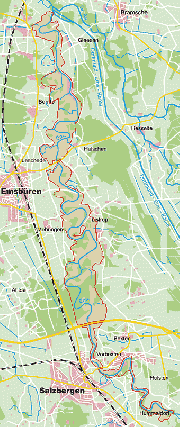Difference between revisions of "Ems floodplain (LIFE project)"
(→Key features of the case study) |
m (→Key features of the case study) |
||
| (One intermediate revision by one other user not shown) | |||
| Line 6: | Line 6: | ||
<Forecasterlink type="getProjectInfoBox" code="73" /> | <Forecasterlink type="getProjectInfoBox" code="73" /> | ||
| − | ==Key features of the case study== | + | == Key features of the case study == |
The Ems is a large sand-bed river and its floodplains were deforested and used for agriculture purpose. The district Emsland has carried out a LIFE project to restore the Ems floodplains: "naturnahe Flussdynamik an der niedersächsischen Ems" (natural river dynamics in the Ems in Lower Saxony). For more information see the website in German: http://www.ems-life.de/ <br> | The Ems is a large sand-bed river and its floodplains were deforested and used for agriculture purpose. The district Emsland has carried out a LIFE project to restore the Ems floodplains: "naturnahe Flussdynamik an der niedersächsischen Ems" (natural river dynamics in the Ems in Lower Saxony). For more information see the website in German: http://www.ems-life.de/ <br> | ||
The main objectives were to remove the bank fixation to allow for natural channel dynamics and to change land-use on the floodplain to allow for natural sucession and the development of a riparian and flooplain forest. Moreover a ramp was build at a dam near the city of Listrup to enhance river continuity and the upstream migration of fish. | The main objectives were to remove the bank fixation to allow for natural channel dynamics and to change land-use on the floodplain to allow for natural sucession and the development of a riparian and flooplain forest. Moreover a ramp was build at a dam near the city of Listrup to enhance river continuity and the upstream migration of fish. | ||
==Site description== | ==Site description== | ||
| − | + | ||
| + | [[Image:emsgebiet.gif|thumb|left|Map of project area from http://www.ems-life.de/]] | ||
| + | |||
==Measures selection== | ==Measures selection== | ||
Latest revision as of 15:57, 26 April 2010
Ems floodplain (LIFE project)
Key features of the case study
The Ems is a large sand-bed river and its floodplains were deforested and used for agriculture purpose. The district Emsland has carried out a LIFE project to restore the Ems floodplains: "naturnahe Flussdynamik an der niedersächsischen Ems" (natural river dynamics in the Ems in Lower Saxony). For more information see the website in German: http://www.ems-life.de/
The main objectives were to remove the bank fixation to allow for natural channel dynamics and to change land-use on the floodplain to allow for natural sucession and the development of a riparian and flooplain forest. Moreover a ramp was build at a dam near the city of Listrup to enhance river continuity and the upstream migration of fish.
Site description

Measures selection
Success criteria
Ecological response
Hydromorphological response
Monitoring before and after implementation of the project
A monitoring has been carried out according to the information given on the website (http://www.ems-life.de/).
Socio-economic aspects
Contact person within the organization
Extra background information
References
Related Measures
- Install fish pass/bypass/side channel for upstream migration
- Remove bank fixation
- Develop riparian forest
- Adjust land use to develop riparian vegetation
- Revegetate riparian zones
- Remove bank fixation